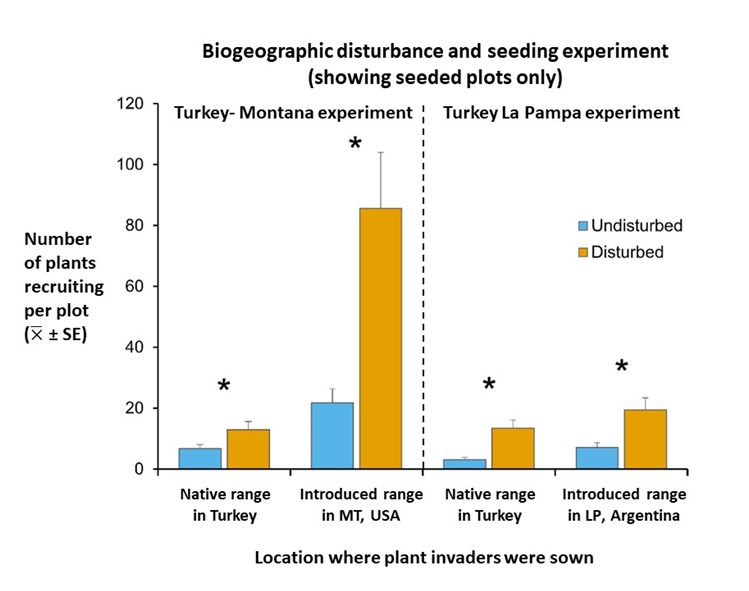|
Getting your Trinity Audio player ready...
|

Dean Pearson discusses his recent article ‘Exotic success following disturbance explained by weak native resilience and ruderal exotic bias‘:
Setting the scene
It’s a common refrain across regions, ecosystems, and continents: disturbance is a major driver of exotic plant invasions. But why is this the case? Even after decades of research exploring this topic, the answer has remained murky. To address this question, we set out to conduct the first biogeographic study of disturbance across multiple plant species (34 species). We experimentally disturbed grasslands and sowed target plant seeds at constant densities while quantifying community responses in one native and two introduced ranges that differed in their susceptibility to invasion. Furthermore, to understand how biogeographic introduction processes might influence outcomes, we also quantified the proportions of ruderal (defined as annual and biennial plants adapted to disturbance) vs perennial species in the donor pool relative to the native and exotic species pools of the introduced ranges. Our findings suggest that invasion outcomes are determined by biogeographic processes that bias species pools in the introduced ranges toward exotic ruderals combined with the capacity of the native to recover from disturbance – community resilience.
The ideas behind the study
Our basic hypothesis was that if the species pool in the donor range tended to be more ruderal than that of the native range and/or if ruderal traits were more likely to pass through biogeographic introduction filters, then we would see exotic species pools that were more biased toward ruderals than native species pools in the introduced ranges. Such a ruderal bias could favor exotics following disturbance. However, the success of ruderal exotics following disturbance should also depend on the response of the native community to disturbance. If the natives exhibit low resilience by responding slowly to close the resource gap created by the disturbance, then exotics should gain an advantage.
The biogeographic disturbance and seed-sowing experiments
We initiated experiments in native-dominated bunchgrass communities located in three distinct regions that share several dominant native plant genera: 1) Turkey (native range), 2) La Pampa, Argentina, and 3) Montana, USA (the latter two introduced ranges). We randomly assigned disturbance and/or seed addition treatments to 1m2 plots within each of three blocks per study area in a full-factorial design. In 2011 and 2012, at the end of each growing season, we manipulated disturbance (by digging up soil and removing roots and shoots) and adding target plant seeds at the same densities for each species in each range. During the peak of the next growing season, we collected data on our variables of interest. We estimated the recruitment of the focal invader plants in each plot, the cover and richness of all taxa (to assess the resilience of the native plant community), the functional composition of the native and introduced communities (to determine how ruderal vs perennial traits affected a community’s response to disturbance), and nutrient levels (focusing on available nitrogen, phosphorus, and potassium). We also assessed the invasibility of each range by looking at the proportion of exotics in local pools and the proportion of total plant cover represented by exotics.

The main takeaways and implications
We found that the donor range had a much higher proportion of ruderals to contribute to the introduced ranges. Moreover, the proportion of ruderals in exotic species pools was further elevated in both introduced ranges relative to the donor range, suggesting that introduction filters select for ruderal plants. As a result of these biogeographic influences, exotic species pools in the introduced ranges were strongly biased toward ruderal species relative to the native species pools. Given the ruderal nature of the invaders, it was not surprising to find that disturbance greatly increased invader success in all ranges (see Figure). Far more interesting was the finding that invader success was much greater in the more invasible introduced range (Montana), where slow-growing, stress tolerant perennials generated lower resilience. In the less-invasible introduced range (La Pampa), invader recruitment was suppressed by competitive native perennials that rapidly rebounded following disturbance, thereby demonstrating strong resilience. Overall, the rate and extent of recovery of the native community played a strong role in determining invader success.
The revelation? Biogeographic processes that select for ruderal exotic invaders combined with weak native plant resilience drove exotic success following disturbance.
Dean Pearson, U.S. Forest Service Rocky Mountain Research Station.
Read the full article online: Exotic success following disturbance explained by weak native resilience and ruderal exotic bias

